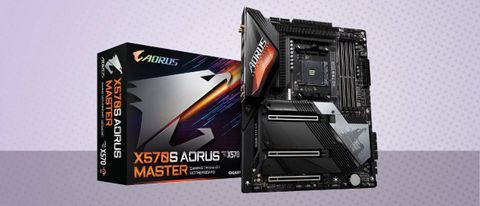Why you can trust Tom's Hardware
Firmware
The Aorus Master’s theme carries over from the original using black/orange as its predominant colors. As usual, we capture a majority of the BIOS screens to share with you. Like most vendors, Gigabyte includes an Easy Mode for high-level monitoring and adjustments, along with an Advanced section for serious tweaking.
The BIOS is organized well, with many commonly used functions accessible without drilling down too far to find them. My biggest gripe in Gigabyte BIOS has to be the inability to use the page up/down buttons to change values. In the end, the BIOS worked well and was easy to navigate and read.




















Software
Gigabyte includes a few applications designed for various functions, including RGB lighting control, audio, system monitoring, and overclocking. Below, we’ve captured several screenshots of the App Center, @BIOS, SIV, RGB Fusion and Easy Tune.




















Test System / Comparison Products
As of July 2021, we’ve updated our test system to Windows 10 64-bit OS (20H2) with all threat mitigations applied. We also upgraded our video card and driver to version 461.40, using an Asus TUF RTX 3070. Additionally, our game selection changed, as noted in the chart below. We use the latest non-beta motherboard BIOS available to the public unless otherwise noted. The hardware used is as follows:
Test System Components
| CPU | AMD Ryzen R9 5950X |
| Memory | GSkill Trident Z Neo 2x8GB DDR4 3600 (F4-3600C16Q-32GTZN) |
| GPU | Asus TUF RTX 3070 |
| Cooling | Corsair H150i |
| PSU | Corsair AX1200i |
| Software | Windows 10 64-bit 20H2 |
| Graphics Driver | NVIDIA Driver 461.40 |
| Sound | Integrated HD audio |
| Network | Integrated Networking (GbE or 2.5 GbE) |
Benchmark Settings
| Synthetic Benchmarks and Settings | Row 0 - Cell 1 |
| PCMark 10 | Version 2.1.2177 64 |
| Row 2 - Cell 0 | Essentials, Productivity, Digital Content Creation, MS Office |
| 3DMark | Version 2.11.6866 64 |
| Row 4 - Cell 0 | Firestrike Extreme and Time Spy Default Presets |
| Cinebench R20 | Version RBBENCHMARK271150 |
| Row 6 - Cell 0 | Open GL Benchmark - Single and Multi-threaded |
| Application Tests and Settings | Row 7 - Cell 1 |
| LAME MP3 | Version SSE2_2019 |
| Row 9 - Cell 0 | Mixed 271MB WAV to mp3: Command: -b 160 --nores (160Kb/s) |
| HandBrake CLI | Version: 1.2.2 |
| Row 11 - Cell 0 | Sintel Open Movie Project: 4.19GB 4K mkv to x264 (light AVX) and x265 (heavy AVX) |
| Corona 1.4 | Version 1.4 |
| Row 13 - Cell 0 | Custom benchmark |
| 7-Zip | Version 19.00 |
| Row 15 - Cell 0 | Integrated benchmark |
| Game Tests and Settings | Row 16 - Cell 1 |
| Far Cry: New Dawn | Ultra Preset - 1920 x 1080 |
| F1 2020 | Ultra Preset - 1920 x 1080 |
MORE: Best Motherboards
MORE: How To Choose A Motherboard
MORE: All Motherboard Content
Current page: Firmware, Software and Test System
Prev Page Features and Specifications Next Page Benchmarks and Final Analysis
Joe Shields is a Freelance writer for Tom’s Hardware US. He reviews motherboards.
-
gjergjik Why the three gigabyte motherboards perform in the 80k point range in 7zip compression test, and the other boards in the 88k-91k point range?Reply
There is a big 10% percent difference. Where does it come from? -
waltc3 More informative article would be a point-by-point comparison with the x570 Aorus Master--which btw is completely silent even with the PCH fan (I don't believe I have ever heard it during the last two years of operation!) I would still choose the plain Master--but the extra NVMe port is nice--still, I like having two LAN controllers (versus 1 in the S) and I especially like the mechanically switched dual-bios in the regular Master! I won't buy a motherboard without those mechanical switches!Reply -
lee280269 Just bought the Arorus Master x570S fanless revision. It was expensive but i now finally have PCIE 4 across the board and i now get the full speeds of all my usb's / M.2's and SSD'sReply
transfer rates for example between the 4 M.2's average between 1.4gbs to 1.9gbs and even my USB type c RAID 0 box with 2 SSD's will consistently transfer 2 separate batches of files at the same time at well over 400mbs each making a usb throughput in excess of 800mbs. 270gb of stuff took just a few mins to throw across.
The only downside to all this speed and unleashed performance is the increased graphics card idle temps as ALL the 4 M.2's sit under a cooling plate directly under the graphics card slot.
